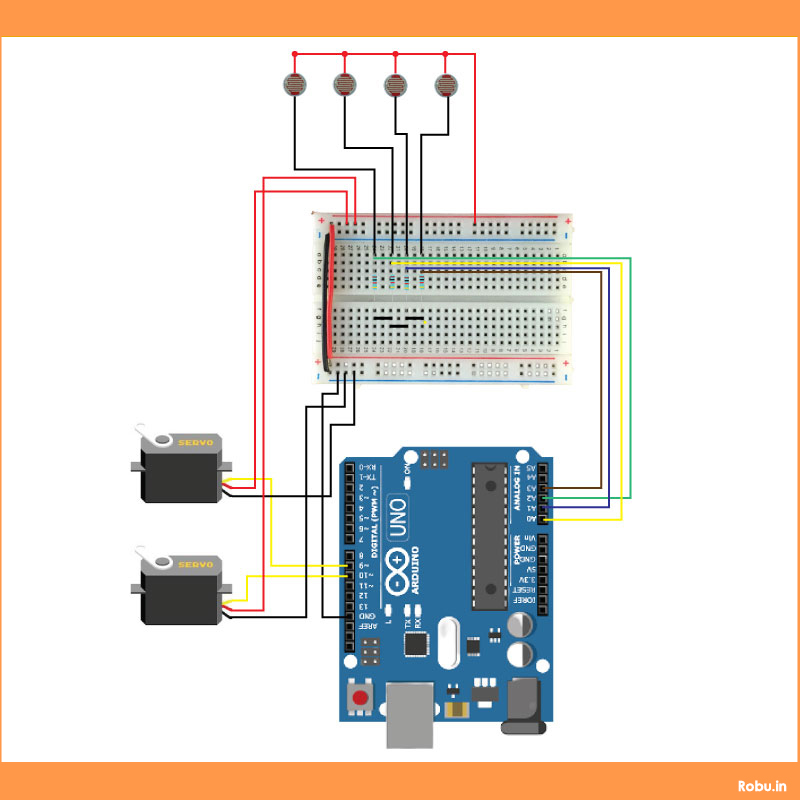This project is designed to track light using two servo motors and four light-dependent resistors (LDRs). The LDRs are placed in different positions to detect light intensity from the top left, top right, bottom left, and bottom right. The servo motors adjust their positions based on the light readings from the LDRs to ensure the system faces the brightest light source.
The code calculates the average light readings from different directions and adjusts the horizontal and vertical servo angles accordingly to move toward the brightest light. This project can be used for solar tracking or similar light-following systems.
CIRCUIT DIAGRAM

CODE
#include <TinyGPS++.h>
#include <SoftwareSerial.h>
#define BLYNK_TEMPLATE_ID "TMPL3Jee8U12h"
#define BLYNK_TEMPLATE_NAME "Dog band"
#define BLYNK_PRINT Serial
#include "MAX30100_PulseOximeter.h"
#include <ESP8266WiFi.h>
#include <BlynkSimpleEsp8266.h>
char auth[] = "sOdeFNHZo2fxa_sGoDKWUYjXyij7l4y4"; // change it to your auth code
char ssid[] = "Oppo A53"; // change it
char pass[] = "NASA@7011"; // change it
int PulseSensorPurplePin = 0; // Pulse Sensor PURPLE WIRE connected to ANALOG PIN 0
//int LED13 = 2; // The on-board Arduion LED
int Signal; // holds the incoming raw data. Signal value can range from 0-1024
int Threshold = 550; // Determine which Signal to "count as a beat", and which to ingore
static const int RXPin = 4, TXPin = 5; // GPIO 4=D2(conneect Tx of GPS) and GPIO 5=D1(Connect Rx of GPS
static const uint32_t GPSBaud = 9600; //if Baud rate 9600 didn't work in your case then use 4800
TinyGPSPlus gps; // The TinyGPS++ object
WidgetMap myMap(V0); // V0 for virtual pin of Map Widget
SoftwareSerial mygps(RXPin, TXPin);
//BlynkTimer timer;
float latitude; //Storing the Latitude
float longitude; //Storing the Longitude
float velocity; //Variable to store the velocity
float sats; //Variable to store no. of satellites response
String bearing;
unsigned int move_index = 1;
void setup()
{
Serial.begin(115200);
mygps.begin(GPSBaud);
Blynk.begin(auth, ssid, pass);
//timer.setInterval(5000L, checkGPS);
}
void checkGPS()
{
if (gps.charsProcessed() < 10)
{
Serial.println(F("No GPS detected: check wiring."));
Blynk.virtualWrite(V3, "GPS ERROR"); // Value Display widget on V3 if GPS not detected
}
}
void loop()
{
while (mygps.available() > 0)
{
// sketch displays information every time a new sentence is correctly encoded.
if (gps.encode(mygps.read()))
if (gps.location.isValid() )
{
sats = gps.satellites.value(); //get number of satellites
latitude = (gps.location.lat()); //Storing the Lat. and Lon.
longitude = (gps.location.lng());
velocity = gps.speed.kmph(); //get velocity
bearing = TinyGPSPlus::cardinal(gps.course.value()); // get the direction
Serial.print("SATS: ");
Serial.println(sats); // float to x decimal places
Serial.print("LATITUDE: ");
Serial.println(latitude, 6); // float to x decimal places
Serial.print("LONGITUDE: ");
Serial.println(longitude, 6);
Serial.print("SPEED: ");
Serial.print(velocity);
Serial.println("kmph");
Serial.print("DIRECTION: ");
Serial.println(bearing);
Blynk.virtualWrite(V2, String(latitude, 6));
Blynk.virtualWrite(V3, String(longitude, 6));
Blynk.virtualWrite(V4, sats);
Blynk.virtualWrite(V5, velocity);
Blynk.virtualWrite(V6, bearing);
myMap.location(move_index, latitude, longitude, "GPS_Location");
}
Serial.println();
}
Signal = analogRead(PulseSensorPurplePin); // Read the PulseSensor's value.
// Assign this value to the "Signal" variable.
Serial.println(Signal);
Blynk.run();
//pulsense = analogRead(A0) - 440;
Serial.println(Signal);
Blynk.virtualWrite(V1, Signal);
//Blynk.virtualWrite(V2, String(lat_val, 6));
//Blynk.virtualWrite(V3, String(lng_val, 6));
if(Signal > Threshold){ // If the signal is above "550", then "turn-on" Arduino's on-Board LED.
Blynk.logEvent("Pulse Rate High", String("Pulse rate is very high. Check your pet."));
} else if(Signal < 50) {
Blynk.logEvent("Pulse Rate Low", String("Pulse rate is very low. Contact a doctor. ")); // Else, the sigal must be below "550", so "turn-off" this LED.
}
//Blynk.logEvent("event_code", String("High TemperatureDetected! Tº: ") + temp);
}











